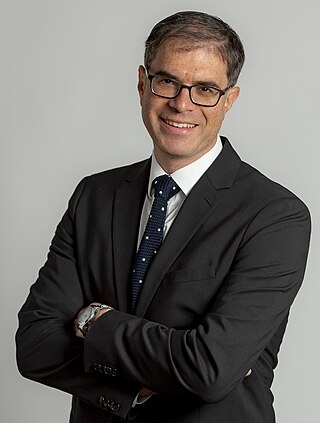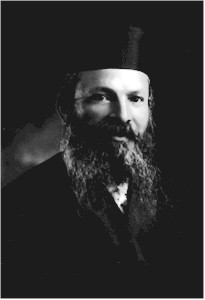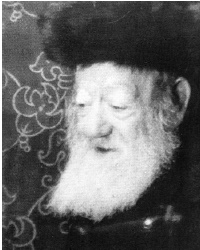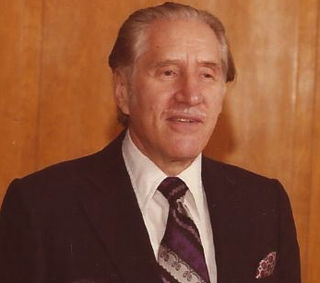Israel Harold "Izzy" Asper was a Canadian tax lawyer and media magnate. He was the founder and owner of the now-defunct TV and media company CanWest Global Communications Corp and father to its former CEO and President Leonard Asper, former director and corporate secretary Gail Asper, as well as former Executive Vice President David Asper. He was also the leader of the Manitoba Liberal Party from 1970 to 1975 and is credited with the idea and vision to establish the Canadian Museum for Human Rights.
Bereavement in Judaism is a combination of minhag (traditions) and mitzvah (commandments) derived from the Torah and Judaism's classical rabbinic literature. The details of observance and practice vary according to each Jewish community.

Har HaMenuchot is the largest cemetery in Jerusalem. The hilltop burial ground lies at the western edge of the city adjacent to the neighborhood of Givat Shaul, with commanding views of Mevaseret Zion to the north, Motza to the west, and Har Nof to the south. Opened in 1951 on 300 dunams of land, it has continually expanded into new sections on the northern and western slopes of the hill. As of 2008, the cemetery encompasses 580 dunams in which over 150,000 people are buried.

Congregation Shaare Zedek is a Conservative synagogue located on West 93rd Street in Manhattan, New York City, New York, in the United States.
Temple Beth Israel is a Reform synagogue located at One Bowman Street in Plattsburgh, New York. Established in 1861, it served Plattsburgh's Jewish population and itinerant Jewish tradesmen in the region. After worshiping in temporary locations, the congregation acquired its first permanent home on Oak Street in 1866. Beth Israel adopted Reform services in 1910, and joined the Union for Reform Judaism in 1913.

Golders Green Jewish Cemetery, usually known as Hoop Lane Jewish Cemetery, is a Jewish cemetery in Golders Green, London NW11. It is maintained by a joint burial committee representing members of the West London Synagogue and the S&P Sephardi Community.
Shaarey Zedek Synagogue is the oldest synagogue in Winnipeg, Manitoba, Canada. Formed in 1880, the congregation's first building was constructed by Philip Brown and several others in 1890. Architect Charles Henry Wheeler designed the original Synagogue on King Street (1889–90).
Solomon Frank was an American–Canadian Orthodox rabbi, speaker, and civic and community leader. He served as rabbinic leader of Shaarey Zedek Synagogue of Winnipeg, Canada, from 1926 to 1947, and spiritual leader of the Spanish and Portuguese Synagogue of Montreal from 1947 until his death. Active in interfaith affairs, he was also a chaplain for Jewish and Christian organizations and hospitals. In Montreal, he broadcast a weekly radio message on Jewish thought and practice for more than 25 years.
Shaarey Tphiloh is a Modern Orthodox Jewish congregation and synagogue located at 400 Deering Avenue, in Portland, Maine, in the United States. The congregation claims it is the oldest continuously operating synagogue in Portland. The name of the synagogue literally means "Gates of Prayer" in Hebrew.

Sanhedria Cemetery is a 27-dunam (6.67-acre) Jewish burial ground in the Sanhedria neighborhood of Jerusalem, adjacent to the intersection of Levi Eshkol Boulevard, Shmuel HaNavi Street, and Bar-Ilan Street. Unlike the Mount of Olives and Har HaMenuchot cemeteries that are located on the outer edges of the city, Sanhedria Cemetery is situated in the heart of western Jerusalem, in proximity to residential housing. It is operated under the jurisdiction of the Kehilat Yerushalayim chevra kadisha and accepts Jews from all religious communities. As of the 2000s, the cemetery is nearly filled to capacity.

The Shaare Zedek Cemetery is a small Jewish burial ground located behind the first Shaare Zedek Hospital in Jerusalem. Originally used by the hospital as farmland for grazing milk cows, the area was converted into a temporary cemetery during the Arab siege of Jerusalem in 1948. Approximately 200 burials were conducted here between March and October of that year. Most graves were transferred to permanent cemeteries after the war, but a handful remain, notably those of several prominent Jerusalem rabbis and the founding director of Shaare Zedek Hospital, Dr. Moshe Wallach.

Rabbi Yehuda Sarna is Chief Rabbi of the Moses Ben Maimon Synagogue of the Abrahamic Family House in Abu Dhabi, UAE. He is also Executive Director of the Bronfman Center for Jewish Student Life at New York University (NYU), Adjunct Assistant Professor of Public Administration at the Robert F. Wagner Graduate School of Public Service and University Chaplain at NYU.
Irwin Dorfman,, was a Canadian lawyer from Winnipeg, Manitoba, eventually becoming senior counsel with the firm of Thompson Dorfman Sweatman. In addition to a busy legal practice in the areas of taxation and corporate matters, he was active in his community and in the profession. He served as president of the Law Society of Manitoba and as the national president of the Canadian Bar Association, the first Jewish president in the Association's history.
The Primrose Path is a 1995 novel by Carol Matas. According to the author, the book "is about sexual abuse, but it's not graphic". In addition to the text, Matas also supplies the reader with a six-page glossary detailing various terms related to the Jewish faith.

Israel Isaac Kahanovitch was a Polish Canadian Orthodox Jewish rabbi who served as Chief Rabbi of Winnipeg and Western Canada for nearly 40 years. Widely respected for his Talmudic erudition and oratory skills, he strengthened Jewish educational, religious, and social institutions and worked to bridge the divide between religious and secular Jews in Canada. He was a founding member of the Canadian Jewish Congress. In 2010, he was named a Person of National Historic Significance by the Government of Canada.

Abba Avraham Shmuel Twersky (1872–1947), known as Shmuel Abba Twersky, was a Rebbe of the Makarover Hasidic dynasty. He succeeded his father as Makarover Rebbe of Berdichev, Ukraine, in 1920, and presided as Makarover Rebbe of Winnipeg, Manitoba, Canada, from 1927 to 1947.

Reuben Slonim was a Canadian rabbi and journalist.
Children of Israel Cemetery is a Jewish cemetery in the Transcona suburb of Winnipeg, Manitoba, Canada. It operated from 1883 to 1933. The cemetery reached a total of 113 graves before it was closed due to frequent flooding. After decades of vandalism and the toppling of headstones due to the elements, Shaarey Zedek Synagogue of Winnipeg negotiated the legal transfer of the burial ground to their management in 1957. The cemetery was then enclosed by a high chain-link fence, and the headstones were laid flat to the ground and embedded in concrete to prevent further damage. The synagogue allows access to the cemetery to those who wish to visit the graves of their family members.
Hebrew Sick Benefit Cemetery is a Jewish cemetery in Winnipeg, Canada. Founded in 1911, it contained approximately 3,500 graves as of 1996. It also contains a war memorial to fallen Jewish servicemen in World War II.









